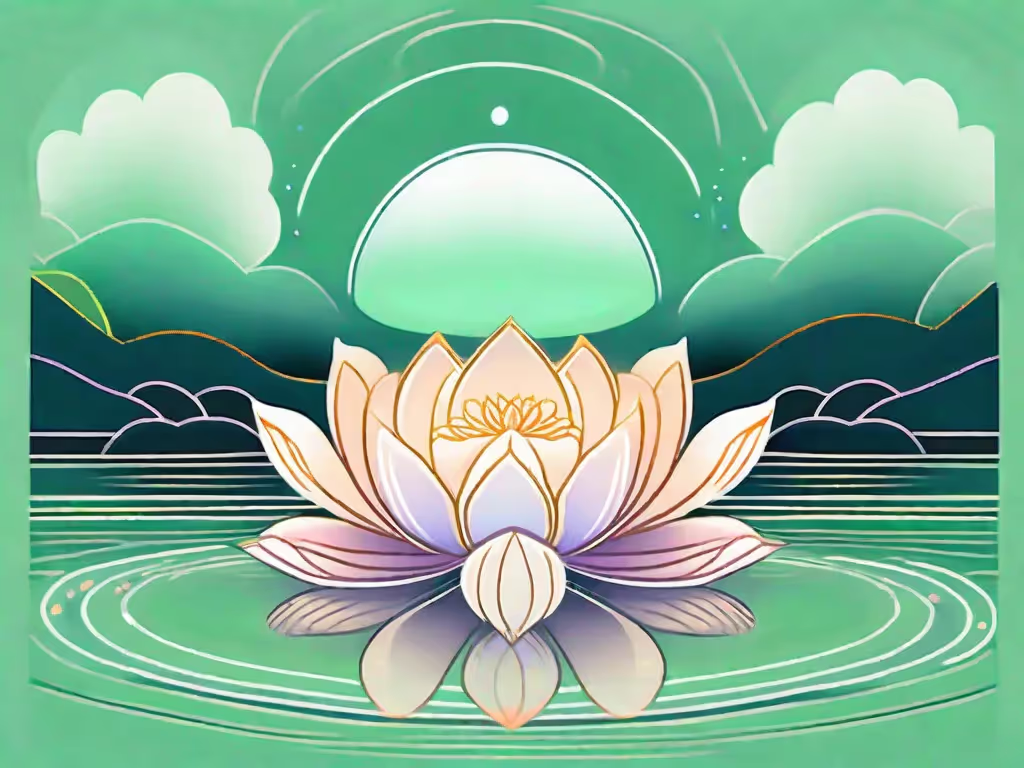Dynamic Meditation is a powerful practice that invites us to fully engage our mind and body, allowing us to find inner balance and serenity amidst the chaos of daily life. It combines movement, breathwork, and mindfulness to create a holistic experience that goes beyond traditional meditation techniques. By understanding the concept of dynamic meditation and exploring its benefits, we can discover a new way to connect with ourselves and cultivate a sense of calm and equilibrium.
Understanding the Concept of Dynamic Meditation
Dynamic Meditation is not a new phenomenon; it has its roots in ancient traditions but has evolved over time to suit the needs and lifestyles of modern practitioners. It is a dynamic and active form of meditation that encourages movement, unlike traditional seated meditation practices. By incorporating physical actions and focusing our attention on the present moment, dynamic meditation offers a unique approach to mindfulness and self-discovery.
When we engage in dynamic meditation, we embark on a journey that takes us beyond the confines of stillness and silence. It is a practice that invites us to explore the depths of our being through movement and conscious action. Through this active form of meditation, we can tap into the wisdom of our bodies and connect with our inner selves in a profound way.
The Origin and Evolution of Dynamic Meditation
Dynamic Meditation finds its origins in various cultures and spiritual practices. Some of the earliest forms of dynamic meditation can be traced back to ancient Chinese and Indian traditions, where movement and breathwork were integral parts of spiritual practices. In China, practices like Qigong and Tai Chi incorporated flowing movements and controlled breathing to cultivate energy and balance within the body. Similarly, in India, practices like Kundalini Yoga and Hatha Yoga involved physical postures, breathwork, and chanting to awaken the dormant energy within.
Over time, these practices have evolved and merged with other disciplines, giving rise to the dynamic meditation techniques we know today. In the 20th century, dynamic meditation gained popularity through the work of Osho, an Indian mystic and spiritual teacher. Osho introduced a specific form of dynamic meditation that involved a series of stages, including catharsis, breathing, and silence. This approach aimed to release repressed emotions, energize the body, and bring about a state of inner stillness.
Key Principles of Dynamic Meditation
Dynamic Meditation is based on several key principles that guide its practice. These principles include being fully present in the moment, embracing movement as a form of expression, and developing a deep mind-body connection. When we engage in dynamic meditation, we are encouraged to let go of distractions and immerse ourselves in the present moment. By doing so, we can cultivate a heightened sense of awareness and experience the richness of each passing moment.
Embracing movement as a form of expression is another fundamental aspect of dynamic meditation. Through movement, we can tap into the wisdom of our bodies and express our emotions, thoughts, and energy in a tangible way. Whether it's through dance, yoga, or other physical practices, movement allows us to release tension, unlock creativity, and connect with our inner selves on a deeper level.
Developing a deep mind-body connection is at the core of dynamic meditation. By synchronizing our breath, movement, and awareness, we can bridge the gap between our physical and mental states. This integration allows us to experience a profound sense of harmony and alignment within ourselves. Through regular practice, we can cultivate a strong mind-body connection that extends beyond our meditation sessions and permeates our daily lives.
The Connection Between Mind and Body in Dynamic Meditation
In dynamic meditation, the mind and body are intricately connected, each influencing the other in a continuous cycle. By understanding and harnessing this connection, we can enhance our meditation practice and cultivate a deeper sense of balance and well-being.
The Role of Physical Movement in Meditation
Movement plays a vital role in dynamic meditation by allowing us to release stagnant energy and build a stronger mind-body connection. Through intentional physical movements such as dancing, stretching, or shaking, we can unlock both physical and emotional tension, creating space for clarity and relaxation.
The Impact of Mental Focus on Physical Well-being
On the other hand, mental focus in dynamic meditation is equally important. By directing our attention to our breath and bodily sensations, we can bring awareness to the present moment and cultivate a state of mindfulness. This combination of physical movement and mental focus allows us to synchronize our mind and body, resulting in enhanced well-being and inner balance.
Techniques of Dynamic Meditation
Dynamic Meditation encompasses various techniques that cater to different preferences and intentions. Whether you prefer a more active practice or a gentle approach, there are techniques that can suit your needs and help you cultivate inner balance.
Breathing Techniques for Dynamic Meditation
Breathwork is a fundamental aspect of dynamic meditation. Techniques such as deep belly breathing, alternate nostril breathing, or breath-focused movements can help us anchor our attention and find a sense of calm amidst the chaos. By harnessing the power of our breath, we can regulate our nervous system, reduce stress, and cultivate a greater sense of inner peace.
Movement Techniques for Dynamic Meditation
In dynamic meditation, movement becomes a form of meditation itself. From expressive dance to mindful walking or even yoga-inspired flows, movement techniques allow us to loosen up our bodies, release tension, and connect with our inner selves. The key is to find movements that feel natural and authentic to you, allowing you to fully embody the practice and find inner balance.
Benefits of Dynamic Meditation for Inner Balance
Dynamic Meditation offers a multitude of benefits that contribute to our overall well-being. From psychological to physical aspects, engaging in this practice can lead to transformative experiences, helping us achieve a heightened state of inner balance.
Psychological Benefits of Dynamic Meditation
Engaging in dynamic meditation can have profound psychological benefits. Recent data shows that dynamic meditation can reduce stress, anxiety, and symptoms of depression. By releasing negative emotions and cultivating a calm mind, we can enhance our emotional resilience and develop a more positive outlook on life.
Physical Benefits of Dynamic Meditation
Moreover, dynamic meditation also offers numerous physical benefits. This practice promotes flexibility, body awareness, and improves overall physical well-being. Regular engagement in dynamic meditation can increase energy levels, improve cardiovascular health, and even boost our immune system. This holistic approach to wellness creates a synergy between our mind and body, leading to a more balanced and healthy lifestyle.
Implementing Dynamic Meditation into Your Daily Routine
To fully embrace the benefits of dynamic meditation, it is essential to incorporate it into our daily routines. By making it a habit, we can experience consistent growth and cultivate a sense of inner balance and serenity.
Best Time and Place for Dynamic Meditation
When considering the best time for dynamic meditation, it is important to find a moment when you can dedicate uninterrupted time and space to yourself. Some people find that starting the day with dynamic meditation sets a positive tone for the rest of their day, while others prefer practicing in the evening to unwind and release the accumulated stress. As for the location, find a peaceful and comfortable environment where you feel relaxed and can move freely without any distractions.
Overcoming Common Challenges in Dynamic Meditation
Engaging in dynamic meditation may present some challenges along the way. It is normal to face resistance or difficulty maintaining focus at times. Despite that, by acknowledging and embracing these challenges, we can develop resilience and continue our practice. It may be helpful to start with shorter sessions and gradually increase the duration as you become more comfortable with the practice.
Dynamic Meditation is a transformative practice that allows us to engage both our mind and body, fostering a deep connection within ourselves. By incorporating movement, breathwork, and mindfulness into our daily lives, we can find inner balance and serenity. So, why not embark on this journey of self-discovery and experience the benefits of dynamic meditation for yourself?
Start your dynamic meditation practice today with the help of the Aura Health App. With its guided meditation sessions and tailored programs, you'll have the tools and support you need to cultivate a sense of inner balance and well-being. Discover a new way to engage your mind and body through dynamic meditation and unlock your full potential.
Aura is Your All In One App for Meditation, Mindfulness Wellbeing
Find peace every day with one app for your whole well-being. There is no one-size-fits-all solution to mental well-being. Aura is the first all-in-one wellness app that learns how to best help you. Discover an endless library of expert-created tracks for your well-being, all taught by the world’s best coaches, therapists, and storytellers. With Aura's personalized recommendations, you can find peace every morning, day and night.



.webp)






.avif)

%20(1).avif)


.avif)
.avif)
.webp)


.avif)


















































































































.avif)

















.svg)






.avif)


